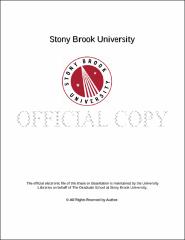| dc.identifier.uri | http://hdl.handle.net/11401/76812 | |
| dc.description.sponsorship | This work is sponsored by the Stony Brook University Graduate School in compliance with the requirements for completion of degree. | en_US |
| dc.format | Monograph | |
| dc.format.medium | Electronic Resource | en_US |
| dc.language.iso | en_US | |
| dc.publisher | The Graduate School, Stony Brook University: Stony Brook, NY. | |
| dc.type | Dissertation | |
| dcterms.abstract | What causes armed movements to last? I address this question by taking up the case of the Maoist movement in India. Through an ethnographic analysis and interviews of 127 current cadre, surrendered militants and non-movement village members in 77 villages, over a period of twelve months in 2013-2014 in three districts in Telangana, India, as well creating and analyzing a database on Maoist incidents (2000-2012), I find that non-violent armed group organizing best predicted movement resilience. Although state and political economy variables formed a base for armed rebellion, organizational structures in the villages determined the presence and sustenance of armed groups in a locale. The Maoists were able to enjoy persistent presence in villages where they focused and succeeded in creating relatively autonomous organizational structures outside formal party structures that could most effectively lead to class formation and build class-consciousness within each village. These village organizational structures, embedded in local socio-economic conditions, with support from the Maoists, were able to withstand state repression and circumvent economic logic, leading to continuous movement presence. This dual organizational structure of party and village organizations that were located outside the formal party structure, with a more open organizational logic, allowed the movement to function in sync with local level fluctuations—changing form and function according to local needs— which became most imperative in sustaining the Maoist insurgency. | |
| dcterms.abstract | What causes armed movements to last? I address this question by taking up the case of the Maoist movement in India. Through an ethnographic analysis and interviews of 127 current cadre, surrendered militants and non-movement village members in 77 villages, over a period of twelve months in 2013-2014 in three districts in Telangana, India, as well creating and analyzing a database on Maoist incidents (2000-2012), I find that non-violent armed group organizing best predicted movement resilience. Although state and political economy variables formed a base for armed rebellion, organizational structures in the villages determined the presence and sustenance of armed groups in a locale. The Maoists were able to enjoy persistent presence in villages where they focused and succeeded in creating relatively autonomous organizational structures outside formal party structures that could most effectively lead to class formation and build class-consciousness within each village. These village organizational structures, embedded in local socio-economic conditions, with support from the Maoists, were able to withstand state repression and circumvent economic logic, leading to continuous movement presence. This dual organizational structure of party and village organizations that were located outside the formal party structure, with a more open organizational logic, allowed the movement to function in sync with local level fluctuations—changing form and function according to local needs— which became most imperative in sustaining the Maoist insurgency. | |
| dcterms.available | 2017-09-20T16:51:13Z | |
| dcterms.contributor | Schwartz, Michael | en_US |
| dcterms.contributor | Burroway, Rebekah | en_US |
| dcterms.contributor | Roxborough, Ian | en_US |
| dcterms.contributor | Goodwin, Jeff | en_US |
| dcterms.contributor | Sundar, Nandini. | en_US |
| dcterms.creator | Tyagi, Juhi | |
| dcterms.dateAccepted | 2017-09-20T16:51:13Z | |
| dcterms.dateSubmitted | 2017-09-20T16:51:13Z | |
| dcterms.description | Department of Sociology | en_US |
| dcterms.extent | 184 pg. | en_US |
| dcterms.format | Application/PDF | en_US |
| dcterms.format | Monograph | |
| dcterms.identifier | http://hdl.handle.net/11401/76812 | |
| dcterms.issued | 2016-12-01 | |
| dcterms.language | en_US | |
| dcterms.provenance | Made available in DSpace on 2017-09-20T16:51:13Z (GMT). No. of bitstreams: 1
Tyagi_grad.sunysb_0771E_12873.pdf: 3191266 bytes, checksum: a4ce793bcc2560da53d867cd78a9f978 (MD5)
Previous issue date: 1 | en |
| dcterms.publisher | The Graduate School, Stony Brook University: Stony Brook, NY. | |
| dcterms.subject | class formation, collective action, India, insurgent movements, Maoists, organizations | |
| dcterms.subject | Sociology | |
| dcterms.title | Organizational Structure and Class: Examining Resilience in the Maoist Movement in India | |
| dcterms.type | Dissertation | |

